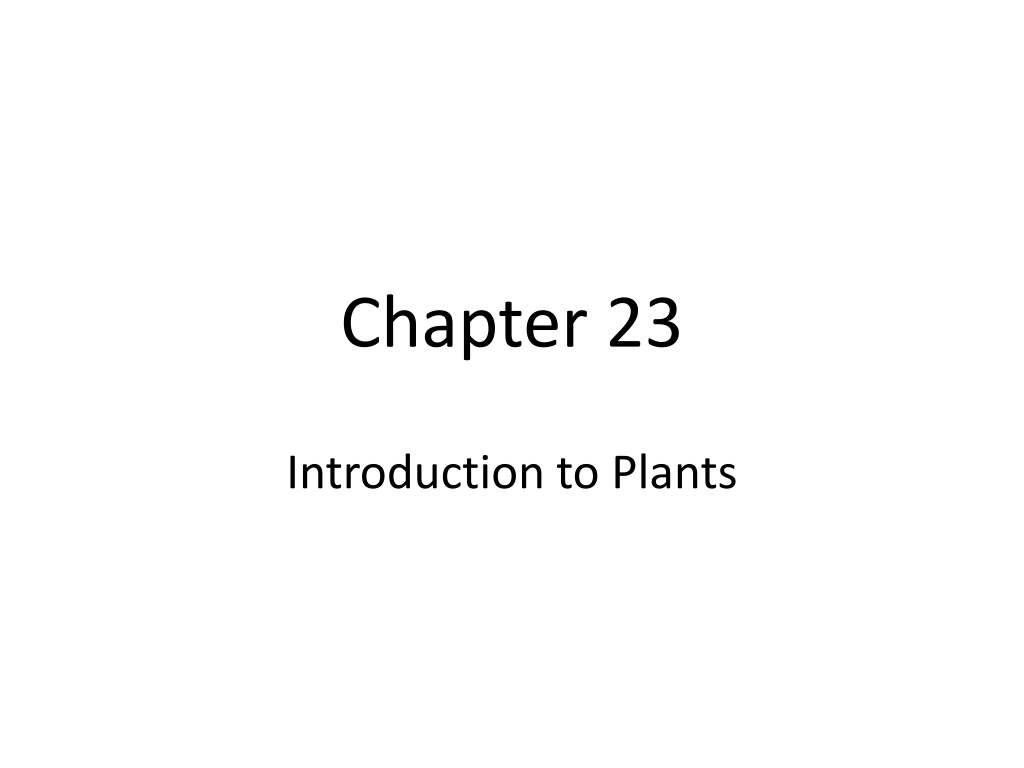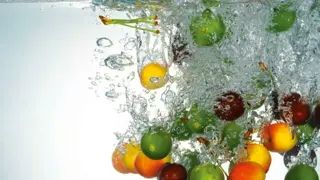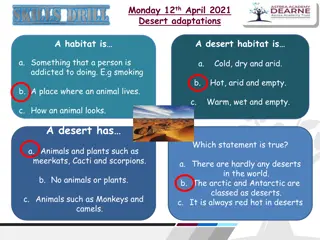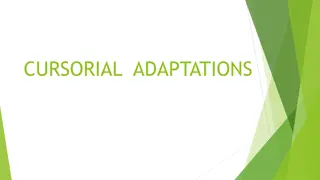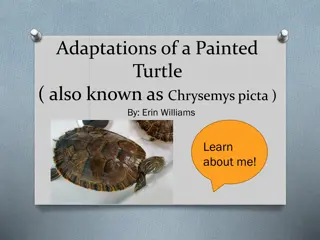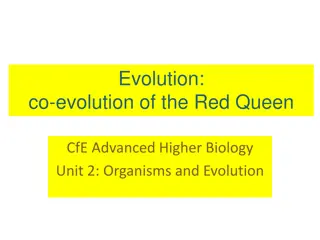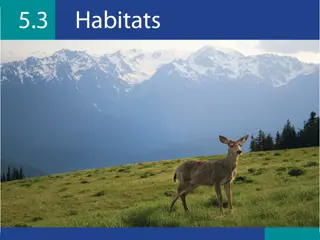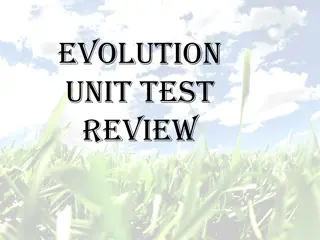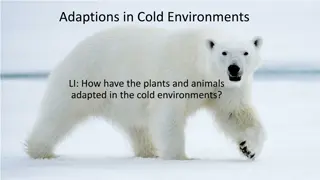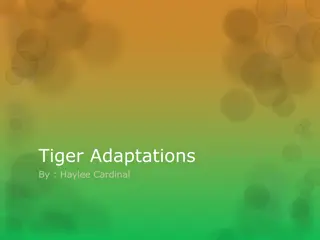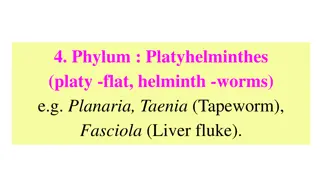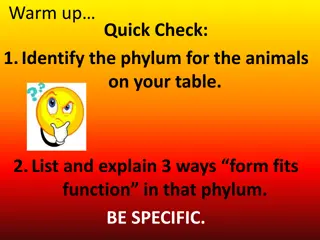Evolution and Adaptations of Plants: A Comprehensive Overview
Plants evolved from multicellular aquatic green algae to establish on land, developing strategies like nutrient absorption from soil, water loss prevention with cuticles, and reproduction without water. Vascular tissue, seeds, and flowers brought further advantages for plant growth and complexity.
Download Presentation

Please find below an Image/Link to download the presentation.
The content on the website is provided AS IS for your information and personal use only. It may not be sold, licensed, or shared on other websites without obtaining consent from the author. Download presentation by click this link. If you encounter any issues during the download, it is possible that the publisher has removed the file from their server.
E N D
Presentation Transcript
Chapter 23 Introduction to Plants
I. Establishment of Plants on land Plants probably evolved from multicellular aquatic green algae that could not survive on land
A. Absorb Nutrients On land, most plants take nutrients from the soil with their roots The first plants had no roots and probably formed symbiotic relationships with fungi to get nutrients from rocky surfaces
B. Prevent water loss A watertight covering called the cuticle reduced water loss The cuticle is a waxy layer that covers the nonwoody parts of a plant that are above ground Pores called stomata allow oxygen gas (O2) and carbon dioxide (CO2) to pass through the cuticle
C. Reproduce without water Aquatic algae reproduce sexually when sperm swim through water to fertilize eggs The sperm of plants must be able to move without water Pollen is a structure that encloses sperm to prevent them from drying out - pollen allows sperm to be carried by wind or animals rather than by water
II. Vascular Tissue, Seeds, and Flowers A. Advantages of conducting tissue The vascular system allowed for plants to grow larger and more complex The vascular system is composed of well- developed vascular tissues that distribute materials more efficiently Specialized cells in vascular tissue are connected end to end and transport water and nutrients within a plant
Plants with a vascular system are called vascular plants Plants without a vascular system are called nonvascular plants - three groups of plants today are nonvascular
B. Advantages of seeds Seeds contain the embryo of a plant Seed plants are vascular plants that produce seeds - make up largest part of plant population Seeds offer a plants offspring several survival advantages
1. Protection A seed coat protects the seed from drying out and from mechanical injury or disease 2. Nourishment Most seeds have a supply of nutrients stored in them
3. Plant dispersal Can be carried away from the parent plant by wind, water, or animals Prevents competition for water, nutrients, light, and living space between plants 4. Delayed growth Seeds can wait to sprout until conditions are most favorable
C. Advantages of Flowers The flower is a reproductive structure that produces pollen and seeds Flowers attract animals which can carry pollen directly from one flower to another
III. Plant Life Cycle In algae, the zygote is the only diploid (2n) cell - zygotes undergo meiosis right after fertilization so bodies of these algae are haploid (n)
In plants, meiosis is delayed after fertilization resulting in an alternation of generations between haploid and diploid plants
Summary: - haploid plants (gametophytes) make haploid gametes by mitosis - diploid plants (sporophytes) make haploid spores by meiosis
In nonvascular plants, the gametophyte (n) generation is dominant In vascular plants, the sporophyte (2n) generation is dominant
IV. The Vascular-Plant Sporophyte A. Vascular System The sporophytes of vascular plants have a vascular system with two types of vascular tissue
1. Phloem Relatively soft-walled cells that transport organic nutrients 2. Xylem Hard-walled cells that transport water and mineral nutrients The thick walls of cells in the xylem help support the plant body - allows the plant to grow to great heights
B. Distinctive body form The part of a plant that grows mostly upward is called the shoot The part of a plant that grows mostly downward is called the root
Meristems are zones of actively dividing plant cells that produce plant growth
V. Kinds of Plants A. Nonvascular Plants Do not have a vascular system for transporting water and nutrients Lack true roots, stems, and leaves
1. Key Features of Nonvascular Plants a. Small size Water and nutrients are transported short distances by osmosis and diffusion - this greatly limits the size of nonvascular plants
b. Larger gametophyte Hairlike projections called rhizoids anchor the gametophytes to the surfaces on which they grow Sporophytes grow on the gametophytes and depend on them for nutrients
c. Require water for sexual reproduction Eggs and sperm form in separate structures usually on separate plants Nonvascular plants must be covered by a film of water for sperm to swim to neighboring individuals to fertilize their eggs
2. Kinds of nonvascular plants a. Mosses leafy green plant parts are gametophytes Most sporophytes grow from the tip of the gametophyte Most have a cuticle, stomata, and some simple conducting cells that carry water short distances
b. Liverworts The gametophytes are flattened and have lobes The sporophytes are very small and consist of a short stalk topped by a spore capsule Do not have cuticles, stomata, or conducting cells
c. Hornworts Gametophytes are green and flattened Sporophytes are green and hornlike Have cuticles and stomata but no conducting cells
B. Seedless Vascular Plants 1. Key features of seedless vascular plants Larger and more complex than nonvascular plants
a. Vascular system Contains both a xylem and phloem Develop true roots, stems, and leaves
b. Larger sporophyte Sporophytes are larger than the gametophytes Large spores are easier to disperse Water is needed for fertilization of eggs by sperm swimming to them c. Drought-resistant spores Spores have thickened walls that are resistant to drying
2. Kinds of seedless vascular plants a. Ferns Have a rhizome, or underground stem, that is anchored by roots Leaves are called fronds Spores are produced in sporangia that grow in clumps on the lower sides of fronds Gametophytes are flattened, heart-shaped, green plants
b. Club mosses Have roots, stems, and leaves that branch from a rhizome Spores develop in sporangia that form on specialized leaves Some of these specialized leaves cluster together to form a structure called a cone
c. Horsetails Have roots, stems, and leaves that branch from a rhizome Stems are hollow and have joints Spores form in cones located at the tips of stems
d. Whisk ferns Highly branched stems No leaves or roots Spores produced in sporangia that form at the tips of short branches
C. Gymnosperms Seed plants whose seeds do not develop within a sealed container (a fruit)
1. Key features of gymnosperms a. Seeds Protect plant embryos, provide them with nutrients, and permit them to survive unfavorable conditions
b. Greatly reduced gametophytes Two types of gametophytes (male and female) form within the tissues of sporophytes Grains of pollen are male gametophytes and develop in male cones Female gametophytes form within structures that become seeds and develop in female cones
c. Wind pollination Water is not required for fertilization allowing sexual reproduction in dry conditions
2. Kinds of gymnosperms a. Conifers Leaves are either needle-like or reduced to tiny scales Berrylike structures are the female cones
b. Cycads Short stems and palmlike leaves - cones that produce pollen and those that produce seeds develop on different plants
c. Ginkgo Fan-shaped leaves Male and female gametophytes develop on separate trees Female seeds do not develop within a cone
d. Gnetophytes Diverse group of trees, shrubs, and vines Produce pollen and seeds in cones that resemble flowers
D. Angiosperms Produce seeds that develop enclosed within a specialized structure called a fruit
1. Key features of angiosperms a. Flowers Male and female gametophytes develop within flowers Promotes pollination and fertilization more efficiently than do cones by attracting insects and animals
b. Fruits Promote seed dispersal as they are eaten by animals and dispersed as they pass undigested from the animals bodies
c. Endosperm A supply of stored food that is absorbed by the embryo before the seeds mature
2. Kinds of angiosperms a. Monocots Flowering plants that produce seeds with one seed leaf Long, narrow leaves with parallel veins Flowers in multiples of 3
b. Dicots Flowering plants that produce seeds with two seed leaves Leaves have branching veins Flowers are in multiples of two, four, or five
